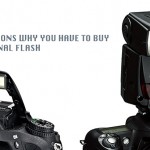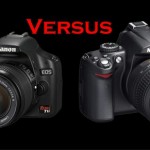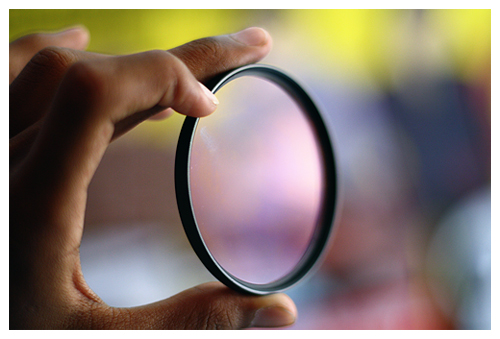
In photography and videography, a filter is a camera accessory consisting of an optical filter that can be inserted in the optical path. The filter can be a square or oblong shape mounted in a holder accessory, or, more commonly, a glass or plastic disk with a metal or plastic ring frame, which can be screwed in front of the lens or clipped onto the lens.Filters need to be coated to reduce flare, and this reduces (slightly) the amount of light that passes through the lens.Filters are (normally) fitted at the very front of a lens and because of this they ‘attract’ flare. Lenshoods are essential when filters are used, but there are many circumstances where a lenshood used without a filter will prevent flare but cannot prevent it when a filter is fitted. Filters allow the photographer to have more control of the images being produced. Sometimes they are used to make only subtle changes to images; other times the image would simply not be possible without them.
Ultra violet filter (UV filter)
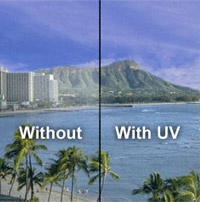
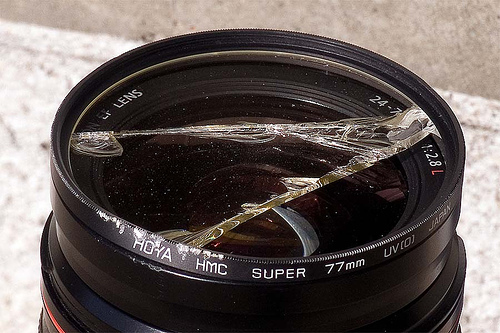
UV filters are individual compounds or mixtures to prevent ultraviolet (UV) light from getting through. UV filters are used in sunscreens to protect skin or in photography to reduce the level of ultraviolet light that strikes the recording medium. It is relatively of low cost and it prevents direct damage to the lens in case the camera is hit. it prevents dust and other dirt from entering the lens ( I had a most unpleasant experience of this kind). In addition, the filter blocks ultra-violet light- thus reducing, even if minimally, the effect of haziness (there are UV filters that are designed specifically to reduce haziness). Because the primary function of the filter is protective, it is prudent to leave it attached to the camera almost always, and thus it is important that it be of high quality. However, UV filters (in particular filters lacking optical coating) may introduce lens flare and have an adverse impact on contrast and sharpness, especially when a strong light source is present.
Polarizer
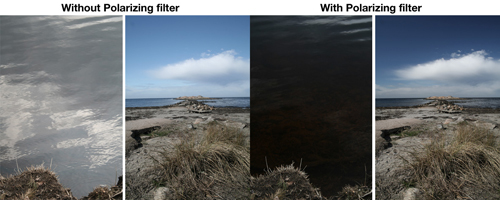
Circular polarizers are specifically designed for use with auto-focus SLR cameras, but they will also work on manual systems without problems. The function of the polarizer is to enable the photographer to control the reflections from non-metalic objects. Use of the filter creates dark hues in the sky, emphasizes the contrast in clouds and other bright objects, and augments color saturation. The polarizer is built out of a “sandwich” of 2 rings, and the rotation of one lens in relation to the other ring determines the effect on the photograph. In order to achieve the maximal effect of the reflection you need to capture them in a 30 degree angle. When photographing the sky, it is recommended to shoot at a 90 degree angle to the sun. The filter diminishes the amount of light that enters in one stop. The polarizer is an expensive filter, relatively speaking. How does this filter works? Good one, well the answer is this – reagular light is unpolarized and so the light waves travel in all planes (horizontal, vertical and so on). You can imagine the polarizer filter as countless tiny vertical slits that only let the vertical light-waves through and block all the others. So when light reflects from a non-metalic it becomes partially polarized and that affects the image due to the filter. The negative aspects of using filters, though often negligible, include the possibility of loss of image definition if using dirty or scratched filters, and increased exposure required by the reduction in light transmitted. The former is best avoided by careful use and maintenance of filters, while the latter is a matter of technique; it usually will not be a problem if planned out properly, but in some situations filter use is impractical.
Neutral density filter (ND filter)
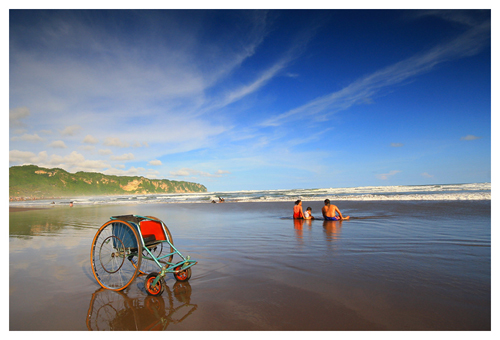
In photography and optics, a neutral density filter or ND filter can be a colorless (clear) or grey filter. An ideal neutral density filter reduces and/or modifies intensity of all wavelengths or colors of light equally, giving no changes in hue of color rendition. This filter decreases the amount of light that is passing through it in an equal manner, without affecting the colors or wavelengths filtered, but just the amount of light. There are many kinds of ND filters, each measured by its strength. Some filters decrease only one stop worth of light (meaning, half the amount of light), and some decrease the light filtered by 3 or 4 stops. The filter allows the photographer to work with long exposures in broad day light, to open the aperture fully in camera that have limited shutter speed, to use film in high speed in day light (we don’t have that problem with digital) and so on. In addition, there is a gradual ND filter that is half transparent and half blocked, so the photographer can capture sunsets in a way that the ground is not under-exposed while the sky isn’t burnt. The purpose of standard photographic neutral density filters is to allow the photographer greater flexibility to change the aperture, exposure time and/or blur of subject in different situations and atmospheric conditions. The ND filter is relatively cheap, but if you’re looking for higher quality – again, money talks
Close-up Filters

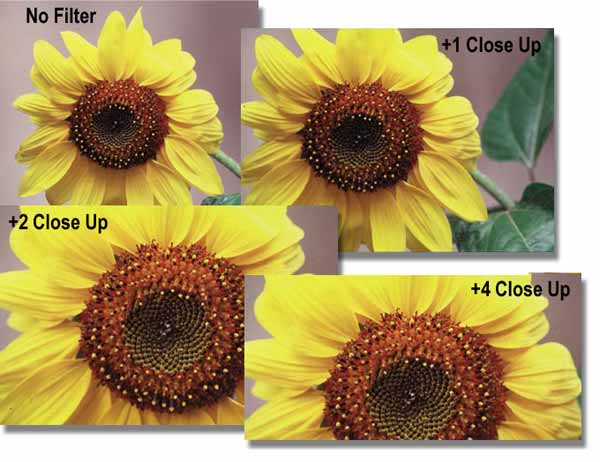
This lens’s job is to allow the lens to focus on much closer objects than the usual limits. In photography, a close-up filter, close-up lens or macro filter is a simple secondary lens used to enable macro photography without requiring a specialised primary lens. They work identically to reading glasses, allowing any primary lens to focus more closely. The photographer can achieve magnificent macro shots with these kinds of lenses. If you wish to expand your knowledge of macro-photography, I wrote a separate guide on the subject in this website. The filters are measured by numbers that represent their strength. +4 lens will be stronger than a +2 lens and so on and so forth. The photographer can stack the lenses one on top of another, thus summing up their strength. For example, a +4 and a +2 together will be equal to a +6 lens. The price of these lenses is not expensive, and a set of 3 lenses +1, +2 and +4 costs about 40$. A B+W deopter with a +10 strength like I have costs about 100 US$.
Infra red filter (IR filter)
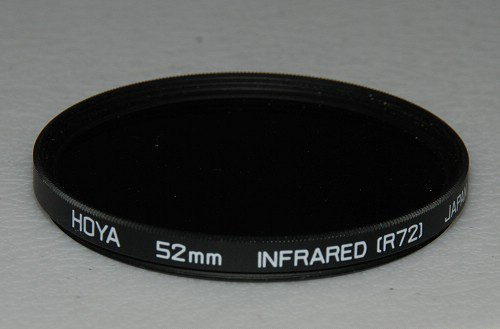
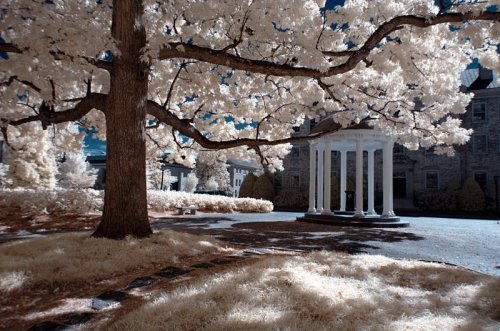
The spectrum of light is much wider than what the human eye can perceive. IR transmitting (passing) filters are commonly used in infrared photography to pass infrared light and block visible and ultraviolet light. Dark black sections of processed film works to pass infrared light and is commonly used as a cheap alternative to expensive glass filters. When a photograph taken with the IR filter is processed in color, it doesn’t look very impressive. But when it is transformed to a black and white photos, the sky is black, the vegetation looks snowy white and even the most recognizable places seem foreign. In a film camera the photographer needs to load IR sensitive film and in a digital camera the photographer needs to make sure that the sensor is sensitive to the IR spectrum and to which wavelengths within that spectrum. In most cameras there is an IR filter that prevents the IR wavelengths from ever reaching the sensor. This built-in filter can be removed, but I wouldn’t recommend messing with it. There are filters for different wavelengths, starting from 650 nm up to 1000 nm. For example, the G3 camera that I had could perform with wavelengths of 720 nm and the Nikon D70 that I now have can perform more or less within that range. Even though the D70 is less sensitive to IR that the G3, it is still more sensitive than other DSLR cameras, like the Canon ones. Because the IR filter blocks most of the light from entering the camera, there is a need for long exposures of more than a few seconds even in mid-day. Some cameras are more sensitive and don’t require such long exposures. The Infra-red filter is expensive, and costs about 100$. It is recommended to read the IR photography article for further information.
Color filters
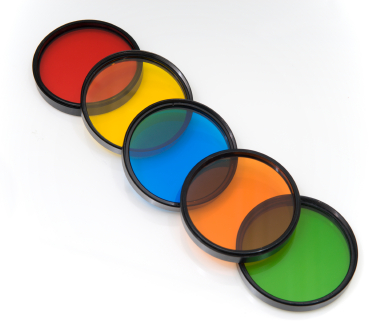
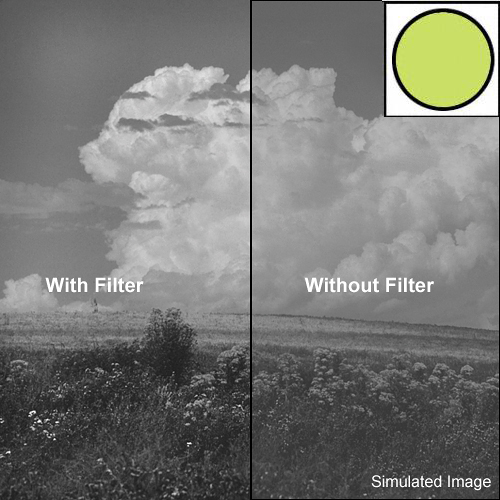
A color gel or color filter (UK spelling: colour gel or colour filter), also known as lighting gel or simply gel, is a transparent colored material that is used in theatre, event production, photography, videography and cinematography to color light and for color correction. Modern gels are thin sheets of polycarbonate or polyester, placed in front of a lighting fixture in the path of the beam. These filters block all of the visible spectrum range except one color, which is allowed to pass through to the camera. In a color photograph the use of the filter will make the entire photo look the same color, which isn’t very impressive. But when you switch to black and white mode, everything becomes much more interesting. A red filter will create an illusion of very dark sky and very bright clouds, everything that is red will look white. In the black and white mode, the color filtered (different color every time, depending on the filter) will appear white and its opposite color will appear black since it is filtered entirely. One should know that a similar effect can be accomplished by manipulating the color channels in photo-shop.
Special and creative filters
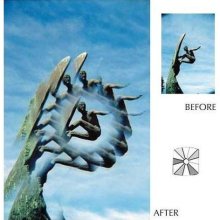
There is a variety of filters that were created to satisfy artistic demands of the photographer and for a dramatic effect. For example, a “star” filter which is a glass with tiny slots across it that create an illusion of a stars out of every light source in the dark. Another example is the “fog” filter, which creates an illusion of fog in every photo. There are many more creative filters that are designed to add that extra kick to a photograph.


